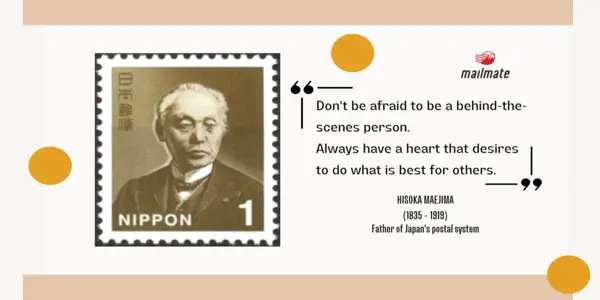Hisoka Maejima, the Father of Japan's Postal System

At 36, Hisoka Maejima 前島密 (1835–1919) founded Japan's postal system. Yet, this was just one of his many pursuits that helped to realize a modern Japan.
We look at how the founder of Japan’s postal system combined Western postal philosophy with pre-existing Edo foundations to implement a unified communications system for Japan—today’s Japan Post.
Maejima’s early days and career
Born Ueno Fusagorō (上野房五郎) in 1835, Maejima's early life and young adulthood were set against the backdrop of a rapidly changing Japan. In 1853, when Commodore Perry's Black Ships entered Edo Bay, an 18-year-old Maejima traveled to view them, becoming fascinated with the ships' weapons and power.

Image. Japanese 1854 print relating Perry's visit. Wikimedia Commons.
Impressed with the importance of learning English and having an affinity for mathematics, Maejima journeyed throughout Japan to learn from tutors who could help him progress in these areas.
His studies paid off. At 30 years old, he was appointed as an English professor. At 31, he became a mathematics professor. In the following years, he acquired port-master duties and became a city magistrate.
In 1868, when Japan's budding Meiji government desired to establish a power base, Maejima proposed Edo (Tokyo) as the new capital, which was accepted and instituted that year.
The following year, in 1869, Maejima was recruited to the Meiji government's kaiseikake「改正掛」(essentially a think-tank), where the government tasked him with creating a railroad survey. He completed his speculative calculations of engineering, construction costs, and income and expenditure in only a few days. Thus, spurring the decision to build a railroad between Tokyo and Yokohama.

Image. First steam train leaving Yokohama Station, 1872. Wikimedia Commons.
In 1870, a 35-year-old Maejima traveled to the UK to study how mail was administered there and quickly grasped techniques and systems. Soon after, in 1871, Japan's first post office was opened, connecting Tokyo and Osaka.
The terms yuubin「郵便」and yuubin kitte「郵便切手」are terms Maejima coined.
The origins of Japan’s postal system: Edo foundation with Western innovations
In founding Japan's Postal System, Maejima decided to innovate and use what was already available. In an interview with Project Design Online, Inoe Takuro, the president of research at Japan's Postal Museum, discussed how Maejima chose to use existing Edo-era (1603–1867) infrastructure while concurrently adopting Western ideas of postal philosophy and system operation.
To explain this point: during Edo, under Tokugawa Ieyasu's rule, the Gokaido was a network of roads and rest stations (shukuba, also known as shuku-eki) used by the shogunate to maintain and facilitate control and communications throughout Japan.

Image. The Tokaido in 1865, Wikimedia Commons.
The roads themselves were well-maintained. Engelbert Kaempfer, a German attached to the Dutch East India Company who visited Japan during 1690-92, noted: "The roads are … lined on both sides with a straight and thick row of fir trees to provide shade and enjoyment for the traveler. … The ground is always kept clean and level. … The road is diligently maintained due to certain sharing arrangements between neighboring villages and headmen and, like the floor of a farmhouse, is cleaned and swept daily."
Edo postal communications for official shogunate use were couriers called tsugi-bikyaku「継飛脚」, and machi-bikyaku「町飛脚」was used by private citizens. (Note: Breaking Barriers: Travel and the State in Early Modern Japan by Constantine Nomikos Vaporis provides an excellent and thoroughly researched treatise on travel during Edo.)

Image. Courier or postman, Japan, hand-colored albumen print by Felice Beato, between 1863 and 1877. Wikimedia Commons.
By utilizing the existing transportation infrastructure of roads and way stations, Maejima swiftly established Japan's new postal system. And by 1872, after only 1 year in operation, Maejima extended postal operations throughout the rest of Japan.
Establishing the predecessor of present-day Nippon Express
The joubikyaku donya 定飛脚問屋, which had been engaged in the delivery of letters and freight since the Edo period, was naturally strongly opposed to the postal service. Maejima persuaded them to establish a transportation company specializing in cargo delivery. And in 1872, Riku-un Moto Kaisha 陸運元会社 was born, the predecessor of the present-day Nippon Express.
Maejima’s proposal regarding Japan’s written language
Today Maejima is well-known for establishing Japan's postal system, but other proposals he promoted during his life reveal the inner compass that guided the many projects he pursued.
Maejima—in a now-famous letter「漢字御廃止之議」to the shogun—proposed the complete abolishment of Chinese characters. While his proposal was never fully adopted, it influenced subsequent Meiji-era reforms and the thinking surrounding Japan's written language.
This short excerpt gets to the heart of Maejima's conflict with Chinese characters:
"If the State is built on the education of its citizens, it is important to extend it to all, regardless of class, and thus to use a script and written language that are as simple as possible. Furthermore, every discipline, the noblest or most profound, must abandon the dry and tortuous study method that requires characters to be learnt before the things themselves are understood. Knowledge should always enable the principle of things to be understood. For this reason learning should be disseminated as in western countries using phonetic symbols - kana - and the use of Chinese characters in everyday texts, both public and private, should be abolished." (Trans. by Pascal Griolet, "Language, script and modernity," Cipango - French Journal of Japanese Studies 2013.)
Maejima’s pursuit of "freedom, equality, and fairness"
Committed to a society that upheld "freedom, equality, and fairness," Maejima resolved that everyone, regardless of titles and hierarchy, should be able to access and use the new postal system—a departure from the segregated postal services that were in place during Edo.
Additionally, he made all sorts of applications that previously required one to go to a government office and beg for help accessible via postal mail.
As the head of postal administration for 11 years, he implemented mail to foreign countries, linked Japan's post to the rest of the world, and established postal money orders, savings, and a simplified insurance plan.
Maejima also founded a newspaper, created land and sea freight transportation proposals, founded Tokyo's Senmon Gakko in 1882 (the predecessor to Waseda University), and helped establish Japan's first telephone exchange line.
The man on Japan’s 1 yen stamp
Today, Hisoka Maejima, the founder of Japan’s postal service, can still be seen on Japan’s 1 yen stamp, which remains in circulation.
His story has enjoyed a renaissance in recent years, thanks to the NHK drama, Reach Beyond the Blue Sky (青天を衝け, Seiten o Tsuke). The TV series takes place during the Meiji period and follows the life of Eiichi Shibusawa, Maejima’s contemporary.
If you can understand Japanese, here’s an explanation of the history behind Episode 29, which covers the kaiseikake and the founding of Japan’s postal system.
Final thoughts
A saying Hisoka Maejima is known for, which he exemplified throughout his life: "Don't be afraid to be a behind-the-scenes person. Always have a heart that desires to do what is best for others."
「縁の下の力持ちになることを厭うな。人のためによかれと願う心を常に持てよ。」
Related articles on Japan’s postal system
Japan Post Forwarding: How to Forward Mail Online [With Pictures]
What Is a Virtual Mailbox Service in Japan? [Your FAQs Answered!]
Spending too long figuring out your Japanese mail?
Virtual mail + translation services start at 3800 per month. 30-day money-back guarantee.

